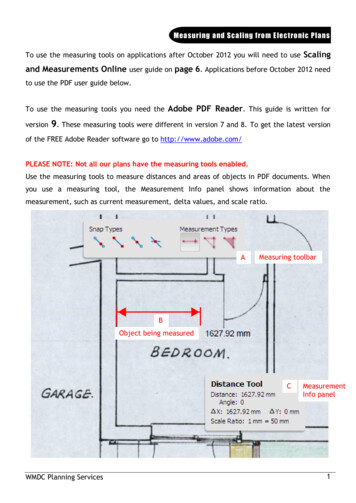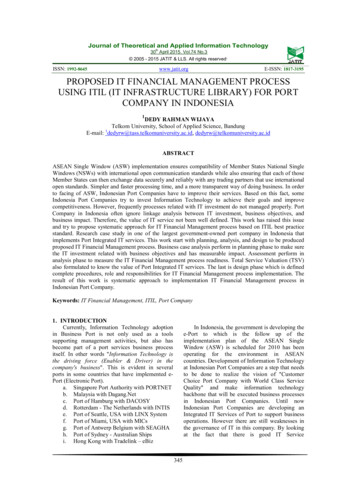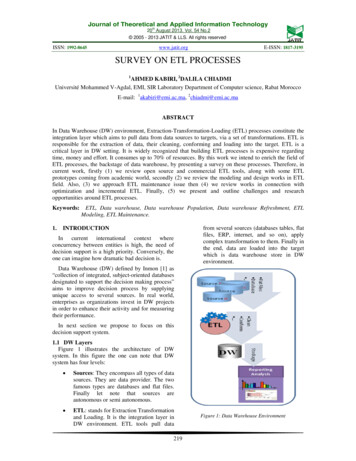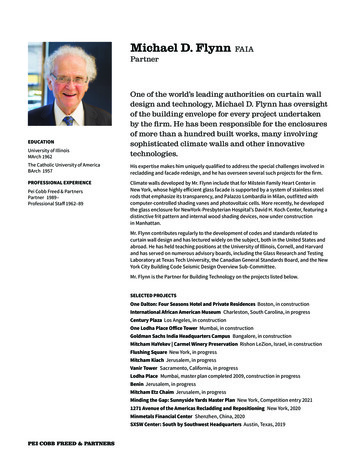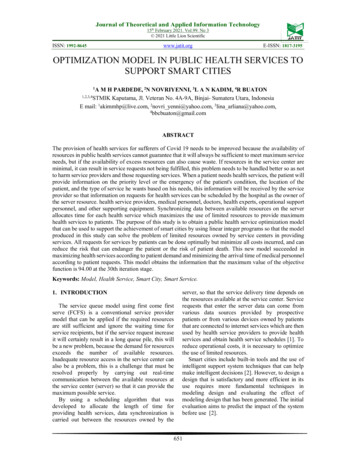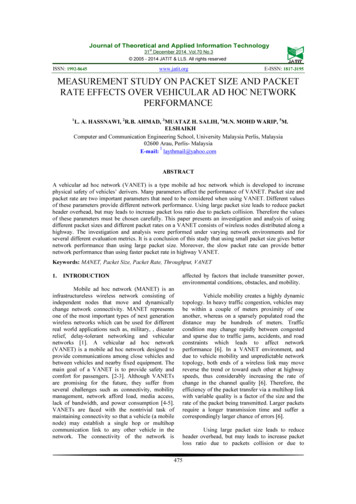
Transcription
Journal of Theoretical and Applied Information Technology31st December 2014. Vol.70 No.3 2005 - 2014 JATIT & LLS. All rights reserved.ISSN: 1992-8645www.jatit.orgE-ISSN: 1817-3195MEASUREMENT STUDY ON PACKET SIZE AND PACKETRATE EFFECTS OVER VEHICULAR AD HOC NETWORKPERFORMANCE1L. A. HASSNAWI, 2R.B. AHMAD, 3MUATAZ H. SALIH, 4M.N. MOHD WARIP, 5M.ELSHAIKHComputer and Communication Engineering School, University Malaysia Perlis, Malaysia02600 Arau, Perlis- Malaysia1E-mail: laythmail@yahoo.comABSTRACTA vehicular ad hoc network (VANET) is a type mobile ad hoc network which is developed to increasephysical safety of vehicles’ derivers. Many parameters affect the performance of VANET. Packet size andpacket rate are two important parameters that need to be considered when using VANET. Different valuesof these parameters provide different network performance. Using large packet size leads to reduce packetheader overhead, but may leads to increase packet loss ratio due to packets collision. Therefore the valuesof these parameters must be chosen carefully. This paper presents an investigation and analysis of usingdifferent packet sizes and different packet rates on a VANET consists of wireless nodes distributed along ahighway. The investigation and analysis were performed under varying network environments and forseveral different evaluation metrics. It is a conclusion of this study that using small packet size gives betternetwork performance than using large packet size. Moreover, the slow packet rate can provide betternetwork performance than using faster packet rate in highway VANET.Keywords: MANET, Packet Size, Packet Rate, Throughput, VANET1.affected by factors that include transmitter power,environmental conditions, obstacles, and mobility.INTRODUCTIONMobile ad hoc network (MANET) is aninfrastructureless wireless network consisting ofindependent nodes that move and dynamicallychange network connectivity. MANET representsone of the most important types of next generationwireless networks which can be used for differentreal world applications such as, military, , disasterrelief, delay-tolerant networking and vehicularnetworks [1]. A vehicular ad hoc network(VANET) is a mobile ad hoc network designed toprovide communications among close vehicles andbetween vehicles and nearby fixed equipment. Themain goal of a VANET is to provide safety andcomfort for passengers. [2-3]. Although VANETsare promising for the future, they suffer fromseveral challenges such as connectivity, mobilitymanagement, network afford load, media access,lack of bandwidth, and power consumption [4-5].VANETs are faced with the nontrivial task ofmaintaining connectivity so that a vehicle (a mobilenode) may establish a single hop or multihopcommunication link to any other vehicle in thenetwork. The connectivity of the network isVehicle mobility creates a highly dynamictopology. In heavy traffic congestion, vehicles maybe within a couple of meters proximity of oneanother, whereas on a sparsely populated road thedistance may be hundreds of meters. Trafficcondition may change rapidly between congestedand sparse due to traffic jams, accidents, and roadconstraints which leads to affect networkperformance [6]. In a VANET environment, anddue to vehicle mobility and unpredictable networktopology, both ends of a wireless link may movereverse the trend or toward each other at highwayspeeds, thus considerably increasing the rate ofchange in the channel quality [6]. Therefore, theefficiency of the packet transfer via a multihop linkwith variable quality is a factor of the size and therate of the packet being transmitted. Larger packetsrequire a longer transmission time and suffer acorrespondingly larger chance of errors [6].Using large packet size leads to reduceheader overhead, but may leads to increase packetloss ratio due to packets collision or due to475
Journal of Theoretical and Applied Information Technology31st December 2014. Vol.70 No.3 2005 - 2014 JATIT & LLS. All rights reserved.ISSN: 1992-8645www.jatit.orgcorruptions in a radio channel or [7]. The transportor link layer use different mechanisms to find errorsin each packet, and drops all packets which containerror bits. Large packet size is more prone to bedropped than the smaller one due to packet biterrors or collisions, since the link layer fragmentsthe large packet into smaller parts which lead toincrease the packet error probability[8]. Thefragmentation can reduce the number ofretransmissions caused by collisions or bit errors,consequently, decreases the overhead caused byretransmissions. On the other hand fragments thelarge packet into smaller parts introduces differentkind of overhead. Smaller parts (packets) introducemore overhead on the network too, because everyfragmented packet sent from one wireless node toanother wireless node requires the receiving node toacknowledge the packet[9]. Depending on the typeof protocols and mechanisms which are used in thelink and physical layers, bit errors decline thenetwork performance in the form of increasedtransmission time delay and packet loss rate[7].Both effects are harmful, especially for real timeapplications such as safety message in VANET.Whereas, the rate of the packet represents thenumber of packets generate by a node per second.Packet rate is an important parameter that canaffects the efficiency of the network. If a sourcenode pumps more data than that which can besupported by the network, it results in highcontention rates at later nodes and will thus degradenetwork performance by increasing number of lostpackets which are dropped due to the packetcollisions. Therefore packet size and packet rateoptimization (network workload) are an essentialresearch problems in wireless telecommunicationsand the value of these parameters must be selectedcarefully in order to obtain a good networkperformance.The main paper objective is to investigate,analyze and demonstrate the effects of workload(packet size and packet rate) over vehicular Ad hocNetwork (VANET) performance in order to find thebest packet size and rate which can be used in thistype of network.The effects of packet size and packet rateover wireless networks are studied and analyzed bymany researchers. The authors in [10] explored theoptimum duration of data packets (packet rate) bydeveloping a mathematical model based ondynamics of Rayleigh fading. They used the rate ofpackets transfer through the radio channel as anevaluation metric. They found that In addition toE-ISSN: 1817-3195the size of the packet, the packet rate depends on:the speed of the mobile node, the channel bit rate,the header size of the packet as well as themodulation and coding techniques. The authorsshowed that In any event, the optimum packets areconsiderably shorter than the 125-byte.A novel Markov model is constructed in[11] to calculate the packet loss probability and thedelay distribution of real-time wireless packets.These packets are transmitted through an erroneouschannel modeled by a two-state Markov chain. Theauthors showed that closed-form solutions areobtained, and simplified expressions assuminghighly correlated errors and small error probabilityare derived. Under these conditions, it is found thatthe packet loss probability is significantly affectedby the delay limit and the transition probability ofthe channel’s remaining in the failure state. On theother hand, they observed that the probability isalmost independent of the arrival rate provided therate is not close to one. Existing techniquesutilizing adaptive packet length in wirelesscommunications were mainly designed to reside inthe medium access control (MAC) or link layer.From the network designer’s point of view, it isnatural to operate in the MAC layer when issuesrelated to the physical transport channel areconsidered. However, in many cases, betterperformance could be achieved if the method forfragmenting data units were optimized for thespecific application. Packet fragmentation in thelink or MAC layer tends to increase bandwidthusage and it is also likely to cause delay due tosegmentation and packet re-assembly operations.The contribution of this research isinvestigating and analyzing the impact of usingdifferent packet sizes and packet rates on theperformance of Highway VANET, in order to findthe adequate values which can be used in this typeof networks.The paper remainder is organized asfollows: packet size and packet rate analysis isdescribed in Section 2. Network modeling andparameters setup are described in Section 3. Theevaluation results and its analysis are demonstratedin Section 4. Finally, the paper conclusions aredemonstrated in Section 5.2.NETWORK WORKLOAD ANALYSISTransmitting large packets over wirelessnetwork increase the efficiency of the network. Inthe case of medium and large packets, the476
Journal of Theoretical and Applied Information Technology31st December 2014. Vol.70 No.3 2005 - 2014 JATIT & LLS. All rights reserved.ISSN: 1992-8645www.jatit.orgperformance of wireless networks is improved byusing some techniques to decrease the number oflost packets which are dropped due to collisions orbit errors, such as RTS/CTS technique whichdecreases the collision effects and fragmentationtechnique which reduces the bit errors effects[12].Both techniques introduce some overhead;therefore, they are not worth using for smallpackets. Although there are no constrains for smallpacket sizes, network designer must be aware of theimpact of using very small packets. Manydisadvantages appear due to using small packets,these are: As compared to the payload size, packetheader overhead becomes too large.Bandwidth requirement becomes high.Rate of the packets increases, which leadsto produce challenging situations for thenetwork.3. SIMULATION SETUPIn this paper, OMNeT [14], was usedfor design the simulation model and perform all theexperiments to evaluate and analyze the effects ofusing different packet sizes and packet rates on theperformance of a VANET.3.1 Highway Model SetupThe model specifications which are usedto evaluate and analyze the effects of workload(packet size and packet rate) on the performance onhighway VANET scenario as a case study is shownbelow: The simulated area is a 6500m straighthighway section with two sides in samedirection. Fifty fixed hosts placed along each sidesof the highway with a 250m separationbetween each two nodes. All fixed nodes in the second side placed125 meters ahead of the nodes in the firstside as demonstrated in Figure 1.Decrease packet transmission delay sincesmall packet size need less time to be sentthan bigger packet size. Six mobile nodes distributed on both sidesof the highway with 50m separationdistance between each two vehicles.No need to retransmit the whole data ifloss occurs due to packet error in network.One has to just retransmit only lostpacket/segment [13]. The nodes’ speed is configured to be 20m/s. Four sizes of data packet are used (0.5, 1,2 and 4 KB). Three values of packet rate are used (1, 2and 3 packets / sec.).The fragmentation is one of the mostimportant techniques which are used to improvenetwork performance. The main advantages ofusing fragmentation are: E-ISSN: 1817-3195However, the main disadvantages of usingfragmentation are: Limiting packet sizes. Fragmentation leads to increases thebandwidth requirement, due to additionalheader overhead. All nodes are configured to use UDPtransport protocol with constant bit rate(CBR) traffic pattern. Packet transmission time increases due tothe operations of segmentation and reassembly. IEEE 802.11g DCF used as a MACprotocol. AODV is used as a routing protocol. The simulation time is 500s for eachexperiment. Nodes mobility is configured according tothe freeway mobility pattern.Therefore, the network designer shouldselect the packet size and packet rate carefully inorder to avoid the fragmentation as well as thelimitations of using small packet sizes.477
Journal of Theoretical and Applied Information Technology31st December 2014. Vol.70 No.3 2005 - 2014 JATIT & LLS. All rights reserved.ISSN: 1992-8645www.jatit.orgE-ISSN: 1817-3195of hops will increase the packet error probability,causing network throughput to decrease.Furthermore, the decreasing level for smallerpacket size is less than the decreasing level for abigger one, because packet error probabilityincreases as packet size increases due to the packetfragmentation, and this case makes the decrease inthroughput larger for 4KB packet size.Figure 1: Highway VANET Scenario3.2 Evaluation MetricsThe evaluation metrics which are chosento analyze the affects of packet size and packet rateon the performance of a VANET are:1.2.4.Throughput – represents number of bits,sent by the network to a certain destinationduring a specific period of time.Packet Transmission Ratio (PTR) represents the efficiency of networkprotocols to the amount of networkworkload. It’s measured by dividingnumber received packets to the number ofsent packets.3.Packet Loss- represents total number ofdropped packets by the nodes.4.Packet Transmission delay – represents theaverage time required by the packets toreach its destination.RESULTS AND ANALYSISDifferent types of tests are performed toevaluate and investigate the effects of usingdifferent packet sizes and different packet rates onthe Highway VANET scenario. Both experimentsperformed to find the adequate values of the packetsize and rate which provides an efficient networkperformance.4.1 Packet SizeFigure 2 depicts the throughput of thenetwork (Kbps) over number of nodes for variablepacket sizes. For each packet size, the throughputof network traffic decreases when the number ofhops between the source and the destinationincreases. This is because increasing in the numberFigure 2: Throughput vs. Number of Nodes betweenSource and DestinationFigure 3 depicts number of lost packetsversus nodes number for variable packet sizes. Foreach packet size, the number of lost packetsincreases with an increase in the number of nodesbetween the source and the destination. Increasingthe number of nodes causes an increase in theprobability that the packet may be dropped while itcompetes to access the wireless channel at eachnode to reach its destination. However, when thisincrease occurs, the number of lost packets willdecrease the PTR as shown in Figure 4. Thedecreasing level of PTR for smaller packet size isless than the decreasing level of PTR for a biggerone, because packet error probability increases aspacket size increases, which leads to an increase inthe number of lost packets and this case makes thedecrease in PTR larger for 4KB packet size.Figure 5 shows that the packettransmission time delay for large packet size isgreater than the transmission time delay for thesmall packet size because the transport layer ofeach node needs more time to transmit a largerpacket size than a smaller one. Moreover,increasing the users’ number will increase thetransmission time delay for all packet sizes becauseincreasing number of users will also increasenumber of packets waiting in the MAC layer bufferto be sent.478
Journal of Theoretical and Applied Information Technology31st December 2014. Vol.70 No.3 2005 - 2014 JATIT & LLS. All rights reserved.ISSN: 1992-8645www.jatit.orgE-ISSN: 1817-3195amount of data injected into the network. This datainjection leads to an increase in throughput (thelarger the packet rate, the higher the throughput). Itshould be pointed out that the network throughputfor all three packet rates decreases as the number ofusers increases. This is because increasing theusers’ number means increasing the amount of datapushed into the network, the consequence is morepacket collision; consequently network throughputdecreases. For comparison purposes, the throughputdecrease for the small packet rate is less that thethroughput decrease for the larger packet rate.Figure 3: Number of Lost Packets vs. Number of Nodesbetween Source and DestinationFigure 6: Network throughput vs. number of users fordifferent packet ratesFigure 4: Packet Transmission Ratio (PTR) vs. Numberof Nodes between Source and DestinationFigure 7 compare packet loss versus thenumber of users. There are three plots, eachindicating a different packet rate. For each packetrate, the number of lost packets increases with anincrease in the number of users. Because when thenumber of users increases, this forces the MAClayer to discard all the overflow packets in itsbuffer. Also increasing the packet rate increases thenumber of packets waiting in the MAC layer bufferto be sent. All the packets that exceed their waitingtime limit are discarded by the MAC layer.Moreover, the Figure shows that the number of lostpackets for the larger rate of packet is higher thannumber of lost packets for the smaller one becauselarger packet rates fill the buffer of the MAC layerfaster than the smaller one.Figure 5: Packet Transmission Time vs. Number of Users4.2 Packet RateFigure 6 shows network throughput(Kbps) versus the number of users for differentpacket rates. Figure 6 shows that an increasingnumber of packets (packets generated by thenodes), the so-called ‘packet rate’, increases theFigure 8, depicts the Packet TransmissionRatio (PTR) over number of users for differentpacket rates. For each packet rate, the PTRdecreases when there is an increase in the numberof users due to higher channel contention. TheFigure shows that the PTR for the higher packetrate is less than the PTR for the smaller packet rate.479
Journal of Theoretical and Applied Information Technology31st December 2014. Vol.70 No.3 2005 - 2014 JATIT & LLS. All rights reserved.ISSN: 1992-8645www.jatit.orgE-ISSN: 1817-3195It can be concluded that this is because with thehigher packet rate, the transport layer needs moretime to transmit the data; consequently, this keepsthe transport layer channel busy, which affects thePTR.Figure 9: Average packet transmission time vs. numberof users for different packet rates5.Figure 7: Number of lost packets vs. number of users fordifferent packet ratesFigure 8: Packet transmission ratio (PTR) vs. number ofusers for different packet ratesFigure 9 shows packet transmission timeover number of users for different packet rates. Foreach packet rate, the packet transmission timeincreases with an increase in the number of users.This is due to the fact that with a higher number ofusers, the transport layer of each node needs moretime to send the data, and increasing the packet rateincreases the number of packets waiting in theMAC layer buffer to be sent, which in turn leads toan increase in the packet transmission time.CONCLUSIONIn a VANET environment, and due tovehicle mobility and unpredictable networktopology, both ends of a wireless link may movereverse the trend or toward each other at highwayspeeds, thus considerably increasing the rate ofchange in the channel quality. Therefore, theefficiency of the packet transfer via a multihop linkwith variable quality is a factor of the size and therate of the packet being transmitted. Larger packetsrequire a longer transmission time and suffer acorrespondingly larger chance of errors which leadsto affect the VANET performance, consequentlythe application efficiency and flexibility. This paperpresents an investigation and analysis of usingdifferent packet sizes and different packet rates onthe efficiency of a highway VANET consisting ofwireless nodes distributed along a highway. Theimpact of using different packet size and differentpacket rate were analyzed under varying networkenvironments and for different evaluation metrics.It has been concluded from the observed results thatusing small packet size at high node mobility speedis better than using large packet size ( 1KB) withrespect to packet loss rate and end-to-endtransmission delay as well as the packettransmission ratio. On the other hand, number oflost packets increases due to an increase in packetsrate which adversely affects the VANETperformance. Therefore, it is preferred to use lowpacket generation rate (less than 3 Packet/s) inheavy traffic congestion and (3 Packet/s in s) insparsely populated road.480
Journal of Theoretical and Applied Information Technology31st December 2014. Vol.70 No.3 2005 - 2014 JATIT & LLS. All rights reserved.ISSN: 1992-8645www.jatit.orgREFERENCES:[1] H. Rashvand and H.-C. Chao, Dynamic ad hocnetworks: The Institution of Engineering andTechnology, 2013.[2] P. Ghosekar, et al., "Mobile ad hocnetworking: imperatives and challenges," IJCAspecial issue on “Mobile ad hoc networks”,MANETs, 2010.[3] R. Krishnan and Z. Zhang, "Mobile Ad-hocNetworking(MANET)FormulationConsidered Harmful," 2013.[4] L. Hassnawi, et al., "Measurement study on theend-to-end data transmission in motorwayssurveillance system using Wireless Ad HocCamera Networks (WAHCN)," in Engineeringand Industries (ICEI), 2011 InternationalConference on, 2011, pp. 1-5.[5] L. Hassnawi, et al., "Performance Analysis ofMotorway Surveillance System Based onWirelessAdHocCameraNetwork(WAHCN)," Journal of Communications &Information Sciences, vol. 2, 2012.[6] A.Boukerche,ALGORITHMSANDPROTOCOLS FOR WIRELESS ANDMOBILE AD HOC NETWORKS. Hoboken,New Jersey: John Wiley & Sons, Inc., 2009.[7] A. McAuley, et al., "Understanding the delayand loss tradeoffs in large wireless militarynetworks using queuing analysis and MACmodels,"inMILITARYCOMMUNICATIONS CONFERENCE, 2012MILCOM 2012, 2012, pp. 1-6.[8] K. K. Kambhatla, et al., "H. 264/AVC videopacket aggregation and unequal errorprotection for noisy channels," in ImageProcessing(ICIP),2012 19th IEEEInternational Conference on, 2012, pp. 16491652.[9] S. Basagni, et al., "Optimized packet sizeselection in underwater wireless sensornetworkcommunications,"OceanicEngineering, IEEE Journal of, vol. 37, pp. 321337, 2012.[10] C. K. Siew and D. Goodman, "Packet datatransmission over mobile radio channels,"Vehicular Technology, IEEE Transactions on,vol. 38, pp. 95-101, 1989.[11] K. K. Lee and S. T. Chanson, "Packet " Vehicular Technology,IEEE Transactions on, vol. 51, pp. 1569-1575,2002.E-ISSN: 1817-3195[12] Y. Li, et al., "Energy modeling andoptimization through joint packet size analysisof BSN and WiFi networks," in PerformanceComputing and Communications Conference(IPCCC), 2011 IEEE 30th International, 2011,pp. 1-8.[13] A. S. Akella, et al., "Method and node fortransmitting data over a communicationnetwork using negative acknowledgment," ed:Google Patents, 2012.[14] A. Varga, "Using the OMNeT discrete eventsimulation system in education," IEEETransactions, vol. 42, p. 11, 1999.481
several different evaluation metrics. It is a conclusion of this study that using small packet size gives better network performance than using large packet size. Moreover, the slow packet rate can provide better network performance than using faster packet rate in highway VANET. Keywords: MANET, Packet Size, Packet Rate, Throughput, VANET 1.


